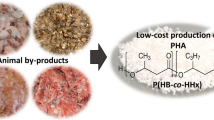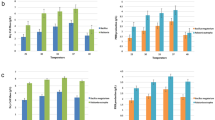Abstract
Conventional polymers are made of crude oil components through chemical polymerization. The aim of the project ANIMPOL is to produce biopolymers by converting lipids into polyhydroxyalkanoates (PHA) in a novel process scheme to reduce dependence on crude oil and decrease greenhouse gas emissions. PHA constitutes a group of biobased and biodegradable polyesters that may substitute fossil-based polymers in a wide range of applications. Waste streams from slaughtering cattle are used as substrate material. Lipids from rendering are used in this process scheme for biodiesel production. Slaughtering waste streams may also be hydrolyzed to achieve higher lipid yield. Biodiesel then is separated into a high- and low-quality fraction. High-quality biodiesel meets requirements for sale as fuel and low quality is used for PHA production as carbon source. Selected offal material is used for acid hydrolysis and serves as a source of organic nitrogen as well as carbon source for PHA-free biomass with high production rate in fermentation process. Nitrogen is a limiting factor to control PHA production during the fermentation process. It is available for bacterial growth from hydrolyzed waste streams as well as added separately as NH4OH solution. Selected microbial strains are used to produce PHA from this substrate. The focus of the paper is about an overview of the whole process with the main focus on hydrolysis, to look for the possibility of using offal hydrolysis as an organic nitrogen substitute. The process design is optimized by minimizing waste streams and energy losses through cleaner production. Ecological evaluation of the process design will be done through footprint calculation according to Sustainable Process Index methodology.


Similar content being viewed by others
Notes
Total biomass (dry matter (dm)) produced in the fermentation process (PHA + residual biomass).
References
Atlić A, Koller M, Scherzer D, Kutschera C, Grillo Fernandes E, Horvat P, Chiellini E, Braunegg G et al (2011) Continuous production of poly([(R]-3-hydroxybutyrate) by Cupriavidus necator in a multistage bioreactor cascade. Appl Microbiol Biotechnol 91:295–304. doi:10.1007/s00253-011-3260-0
Braunegg G, Lefebvre G, Renner G, Zeiser A, Haage G, Loidl-Lanthaler K (1995) Kinetics as a tool for polyhydroxyalkanoate production optimization. Can J Microbiol 41:239–248. doi:10.1139/m95-192
Braunegg G, Lefebvre G, Genser KF (1998) Polyhydroxyalkanoates, biopolyesters from renewable resources: physiological and engineering aspects. J Biotechnol 65:127–161. doi:10.1016/S0168-1656(98)00126-6
Chen G-Q (2010) Plastics completely synthesized by bacteria: polyhydroxyalkanoates. In: Chen G-Q (ed) Plastics from bacteria: natural functions and applications, microbiology monographs, vol 14. Springer, Berlin, pp 17–37. doi:10.1007/978-3-642-03287-5_2
Choi J, Lee SY (1999) Factors affecting the economics of polyhydroxyalkanoate production by bacterial fermentation. Appl Microbiol Biotechnol 51:13–21. doi:10.1007/s002530051357
Cunha ME, Krause LC, Moraes MSA, Faccini CS, Jacques RA, Almeida SR, Rodrigues MRA, Caramão EB et al (2009) Beef tallow biodiesel produced in a pilot scale. Fuel Process Technol 90:570–575. doi:10.1016/j.fuproc.2009.01.001
Europe’s Energy Portal (n.d.), http://www.energy.eu/, last accessed 08.06.2011
European Union (2002), Regulation (EC) No 1774/2002 of the European parliament and of the council of 2002 laying down health rules concerning animal by-products not intended for human consumption, Official journal of the European Communities L273:1–95
Gwehenberger G, Narodoslawsky M (2008) Sustainable processes—the challenge of the 21st century for chemical engineering. Process Safety Environ Prot 8:321–327. doi:10.1016/j.psep.2008.03.004
ICIS (n.d.), Chemical prices and chemical industry trends from ICIS pricing, http://www.icispricing.com/il_shared/Samples/SubPage110.asp, last accessed 08.06.2011
IEA (2008) International Energy Agency, Energy Statistics, http://www.iea.org/stats/index.asp, last accessed 08.06.2011
Kettl K-H, Niemetz N, Sandor N, Narodoslawsky M (2011) Ecological impact of renewable resource-based energy technologies. J Fundam Renew Energy Appl 1:1–5. doi:10.4303/jfrea/R101101
Khanna S, Srivastava AK (2005) Recent advances in microbial polyhydroxyalkanoates. Process Biochem 40:607–619. doi:10.1016/j.procbio.2004.01.053
Khardenavis AA, Kumar MS, Mudliar SN, Chakrabarti T (2007) Biotechnological conversion of agro-industrial wastewaters into biodegradable plastic, poly–ßhydroxybutyrate. Bioresour Technol 98:3579–3584. doi:10.1016/j.biortech.2006.11.024
Koller M, Braunegg G, Bona R, Hermann C, Horvat P, Martinz J, Neto J, Pereira L, Varila P, Kroutil M (2005a) Production of polyhydroxyalkanoates from agricultural waste and surplus materials. Biomacromolecules 6:561–565. doi:10.1021/bm049478b
Koller M, Bona R, Hermann C, Horvat P, Martinz J, Neto J, Pereira L, Varila P, Braunegg G (2005b) Biotechnological production of poly (3-hydroxybutyrate) with Wautersia eutropha by application of green grass juice and silage juice as additional complex substrates. Biocatal Biotransform 23(5):329–337. doi:10.1080/10242420500292252
Koller M, Bona R, Chiellini E, Grillo FE, Horvat P, Kutschera C, Hesse PJ, Braunegg G (2008) Polyhydroxyalkanoate production from whey by Pseudomonas hydrogenovora. Bioresour Technol 99:4854–4863. doi:10.1016/j.biortech.2007.09.049
Koller M, Salerno A, Sousa Dias M, Reiterer A, Braunegg G et al (2010) Modern biotechnological polymer synthesis: a review. Food Technol Biotechnol 48(3):255–269
Koller M, Gasser I, Schmid F, Berg G (2011) Linking ecology with economy: insights into PHA producing microorganisms. Eng Life Sci 11:222–237. doi:10.1002/elsc.201000190
Koller M, Salerno A, Reiterer A, Malli H, Malli K, Kettl KH, Narodoslawsky M, Schnitzer H, Chiellini E, Braunegg G (2012) Sugarcane as feedstock for biomediated polymer production. Sugarcane production, cultivation and uses. Nova Science Pub Inc, Hauppauge
Moser A (1988) Bioprocess technology: kinetics and reactors. Springer-Verlag, New York
Narodoslawsky M, Krotscheck Ch (1995) The Sustainable Process Index (SPI): evaluating processes according to environmental compatibility. J Hazard Mater 41:383–397. doi:10.1016/0304-3894(94)00114-V
Neto J (2006) New strategies in the production of polyhydroxyalkanoates from glycerol and meat and bone meal. Ph.D Thesis, Graz University of Technology, Graz, Austria
Niederl- A, Narodoslawsky M (2004) Life Cycle assessment—study of biodiesel from tallow and used vegetable oil, Graz University of Technology, Graz, last accessed 08.06.2011
Nonato RV, Mantelatto PE, Rossell CE (2001) Integrated production of biodegradable plastic, sugar and ethanol. Appl Microbiol Biotechnol 57:1–5. doi:10.1007/s002530100732
OPEC (2009)Monthly Oil Market Report January 2009. Organization of Petroleum Exporting Countries. http://www.opec.org/opec_web/static_files_project/media/downloads/publications/MR012009.pdf, last accessed 25.10.2011
Pitt M (n.d.), Chemicals cost guide, http://ed.icheme.org/costchem.html, last accessed 08.06.2011
Riedl Ch (2003) Stoffstromanalyse in Schlachthöfen. MSc Thesis, Graz University of Technology, Graz, Austria
Sandholzer D, Narodoslawsky M (2007) SPIonExcel—fast and easy calculation of the Sustainable Process Index via computer. Resour Conserv Recycl 50(2):130–142. doi:10.1016/j.resconrec.2006.06.012
Solaiman DKY, Ashby RD, Foglia TA, Marmer WN (2006) Conversion of agricultural feedstock and coproducts into poly(hydroxyalkanoates). Appl Microbiol Biotechnol 71:783–789. doi:10.1007/s00253-006-0451-1
Stelmachowski M (2011) Utilization of glycerol, a by-product of the transesterification process of vegetable oils: a review. Ecol Chem Eng 18(1):9–30
Sudesh K, Iwata T (2008) Sustainability of biobased and biodegradable plastics. Clean Soil Air Water 36:433–442. doi:10.1002/clen.200700183
Sun Z, Ramsay JA, Guay M, Ramsay BA (2007) Fermentation process development for the production of medium-chain-length poly-3-hydroxyalkanoates. Appl Microbiol Biotechnol 75:475–485. doi:10.1007/s00253-007-0857-4
Zinn M, Weilenmann HU, Hany R, Schmid M, Egli T (2003) Tailored synthesis of poly([R]-3-hydroxybutyrate-co-3-hydroxyvalerate) (PHB/HV) in Ralstonia eutropha DSM 428. Acta Biotechnologica 23:309–316. doi:10.1002/abio.200390039
Author information
Authors and Affiliations
Corresponding author
Rights and permissions
About this article
Cite this article
Titz, M., Kettl, KH., Shahzad, K. et al. Process optimization for efficient biomediated PHA production from animal-based waste streams. Clean Techn Environ Policy 14, 495–503 (2012). https://doi.org/10.1007/s10098-012-0464-7
Received:
Accepted:
Published:
Issue Date:
DOI: https://doi.org/10.1007/s10098-012-0464-7




